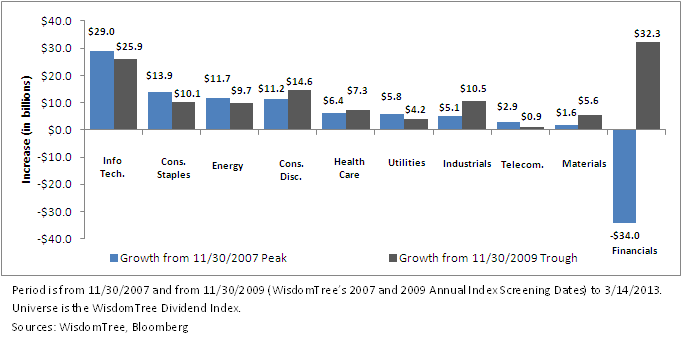Fast and Furious Dividend Growth to Start 2013


 • Information Technology: This sector accounts for over 50% of the increase in dividends from November 30, 2007, to March 14, 2013, with $29 billion of the $53.5 billion total increase in dividends. Technology firms are generally recent initiators with lots of cash on their balance sheets and potential for further dividend growth. From the November 30, 2009, low, this sector accounted for about 21% of the increase.
• Financials: At the November 30, 2007, screening date, Financials comprised approximately one-third of the total dividend stream, but today they comprise only about 17%. Recent growth has been strong—with over $32 billion from the bottom in 2009 after the cuts through today. The latest increase came after the Fed’s approval of their stress test results. Financials are still about $34 billion short of their November 30, 2007, high, though—the only sector that is still below its pre-financial crisis highs.
• Broadness of Growth: It is remarkable to us that 9 out of 10 sectors have grown from the November 30, 2007, level and all 10 are higher than where they were on November 30, 2009.
Positioning to Capture the Market’s Dividend Growth
I continue to believe it is important to be broadly diversified in the market to capture the dividend growth. Financial firms, though still on the comeback trail, are widely expected to continue growing their dividends pending approval from the U.S. government. Information technology firms have large amounts of cash, so we may see more dividend initiations as well as dividend growth from that sector.
Ultimately, strategies focused on backward looking and regular cycles of 5, 10 or 20 years of consecutive dividend increases are likely to miss out on the new up-and-coming dividend payers (or those that cut dividends during the crisis, such as the aforementioned J.P. Morgan and Wells Fargo). With WisdomTree’s U.S. Dividend family, once a firm indicates a regular dividend and meets other market capitalization and liquidity screens, it becomes eligible for inclusion, allowing these strategies to move quickly to capture the U.S. dividend stream as it evolves.
Unless otherwise noted, sources are WisdomTree and Bloomberg.
For current holdings in the WisdomTree Dividend Index, click here.
• Information Technology: This sector accounts for over 50% of the increase in dividends from November 30, 2007, to March 14, 2013, with $29 billion of the $53.5 billion total increase in dividends. Technology firms are generally recent initiators with lots of cash on their balance sheets and potential for further dividend growth. From the November 30, 2009, low, this sector accounted for about 21% of the increase.
• Financials: At the November 30, 2007, screening date, Financials comprised approximately one-third of the total dividend stream, but today they comprise only about 17%. Recent growth has been strong—with over $32 billion from the bottom in 2009 after the cuts through today. The latest increase came after the Fed’s approval of their stress test results. Financials are still about $34 billion short of their November 30, 2007, high, though—the only sector that is still below its pre-financial crisis highs.
• Broadness of Growth: It is remarkable to us that 9 out of 10 sectors have grown from the November 30, 2007, level and all 10 are higher than where they were on November 30, 2009.
Positioning to Capture the Market’s Dividend Growth
I continue to believe it is important to be broadly diversified in the market to capture the dividend growth. Financial firms, though still on the comeback trail, are widely expected to continue growing their dividends pending approval from the U.S. government. Information technology firms have large amounts of cash, so we may see more dividend initiations as well as dividend growth from that sector.
Ultimately, strategies focused on backward looking and regular cycles of 5, 10 or 20 years of consecutive dividend increases are likely to miss out on the new up-and-coming dividend payers (or those that cut dividends during the crisis, such as the aforementioned J.P. Morgan and Wells Fargo). With WisdomTree’s U.S. Dividend family, once a firm indicates a regular dividend and meets other market capitalization and liquidity screens, it becomes eligible for inclusion, allowing these strategies to move quickly to capture the U.S. dividend stream as it evolves.
Unless otherwise noted, sources are WisdomTree and Bloomberg.
For current holdings in the WisdomTree Dividend Index, click here.Important Risks Related to this Article
Investing involves risk, including loss of principal. Dividends are not guaranteed and a company’s future abilities to pay dividends may be limited. A company currently paying dividends may cease paying dividends at any time.

Jeremy Schwartz has served as our Global Chief Investment Officer since November 2021 and leads WisdomTree’s investment strategy team in the construction of WisdomTree’s equity Indexes, quantitative active strategies and multi-asset Model Portfolios. Jeremy joined WisdomTree in May 2005 as a Senior Analyst, adding Deputy Director of Research to his responsibilities in February 2007. He served as Director of Research from October 2008 to October 2018 and as Global Head of Research from November 2018 to November 2021. Before joining WisdomTree, he was a head research assistant for Professor Jeremy Siegel and, in 2022, became his co-author on the sixth edition of the book Stocks for the Long Run. Jeremy is also co-author of the Financial Analysts Journal paper “What Happened to the Original Stocks in the S&P 500?” He received his B.S. in economics from The Wharton School of the University of Pennsylvania and hosts the Wharton Business Radio program Behind the Markets on SiriusXM 132. Jeremy is a member of the CFA Society of Philadelphia.

